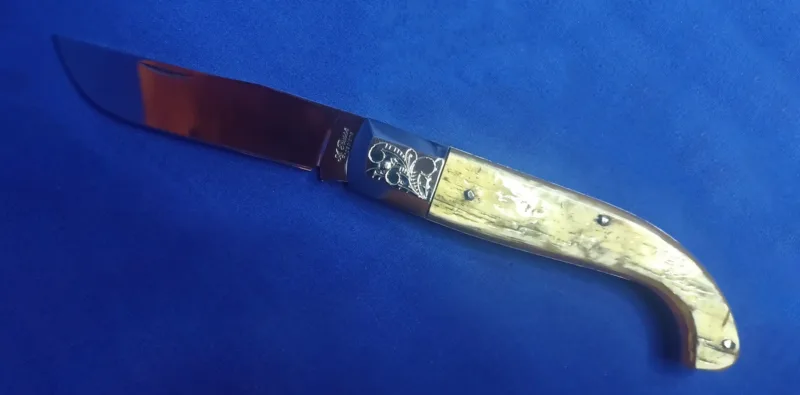ALLA ROMANO
This knife is called “alla romano”. There are traces of this knife since the early 19th century. They were mainly used for dueling. They were forbidden by the Papal laws but never the less were still produced and used. The Papal State, also known as the Ecclastical State of Patrimony of St. Peter (stato della chiesa was its official name until 1815), was an italian state made up of all the territories over which the Holy See exercised its temporal power from 756 to 1870.

ARBURESA
The town of Arbus is at the center of a vast area known since the Nuragic age for the wealth of metal deposits and mines which remained active until the 20th century, as evidenced by the grandiose remains of 1 of the best known mining sites in the world, the Ingurtosu complex, where lead and zinc are mined. The mining activity ensured that raw materials for the tools necessary for the activity of shepherds, farmers, and miners and favored the presence of various forges which made objects of daily use, including knives. After the middle of the 19th century, a type of knife known today as the “arresoja arburesa”, spread in Arbus, which has kept the structure similar to the older Cagliari or (ancient shape) of Iberian derivation. It has a broad, rounded blade in the shape of a bay leaf which ends with a sharp crescent point. The handle often with goat or ram horn, is one piece, (monolithic), has a charecteristic arched shaped shape that follows the edge of the blade and is engraved to house the blade itslef. The most recent models have 2 rings at the end of the handle.
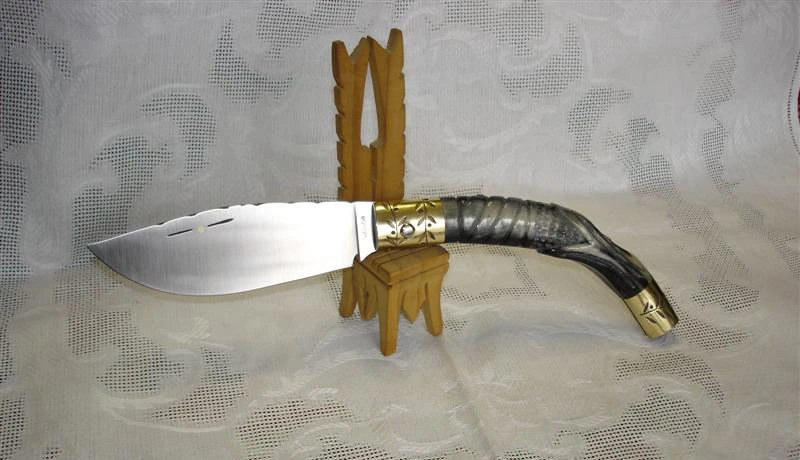
CAGLARITANI
The city of Cagliari boasts a long tradition in regards to the forging of blades since the beginning of the Catalan-Aragonese domination in the 14th century, even if the first accurate documents that have come down date back to the 17th century, when in the statutes of the “ganiveter” (Catalan term for blacksmiths) of the city a “resoia” is mentioned, a knife whose shape, however, is unknown. A model of knife that was produced in Cagliari and its surroundings dates back to the mid 19th century, which has benn referred to as “foggia antica” meaning ancient shape but which would be better called “Cagliaritana”; it is a leather folding knife probably of Iberian derivation since very similar to the spanish navaja, whose main feature is the rounded blade fixed to the monobloc handle with 2 rings at the ends. This model later spread north of Cagliari, particularily in the Arburese and Guspinese regions.Today very few of the master cutlers of Sardinia produce excellent specimens of the Cagliari.
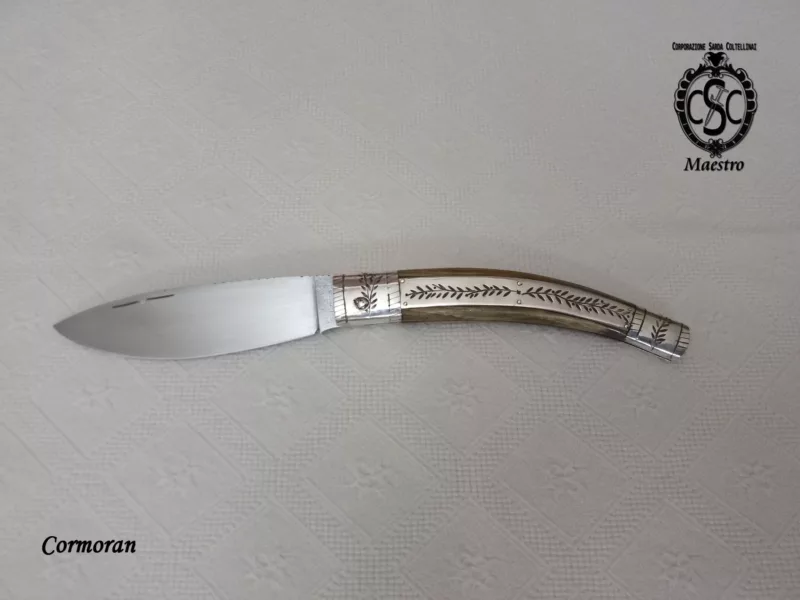
Cuttedu Ammanicatu
The cuttedu ammanicatu is a particular traditional dueling knife from the area of Catania and surrounding areas….it is a knife equipped with a blade locking system “a camma” (cam) which made it very safe during combat in duels with knife or knife and stick. The measurements usually ranged in length from 40-42cm up to even larger measures. The blade and spring were forged in recycled steel while the handle was almost always in bovine or ram horn. Very often this type of knife was enriched with various file decorations both on the handle and on the blade which could vary from maker to maker in order to imprint their own “brand” and to enhance their manual skills. The cuttedu ammanicatu was used according to very precise and effective fencing techniques that were very often handed down secretly by the old masters and only to a few really deserving students.
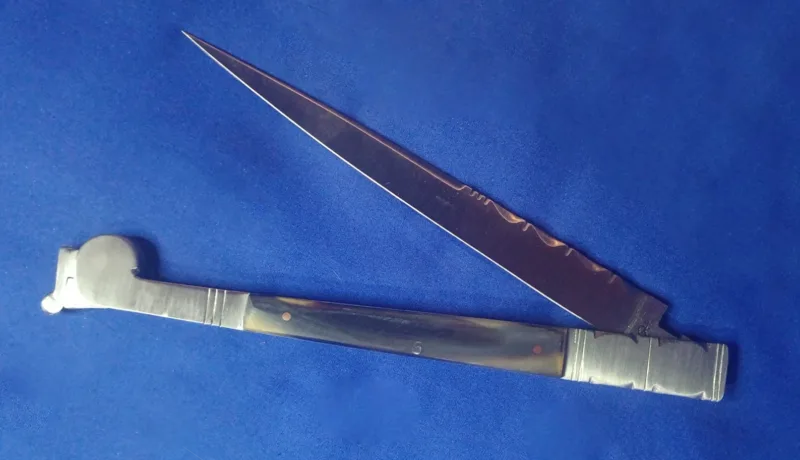
GONNESA
The town of Gonnosfanadiga, of which the Gonnesa is named after, is located on the slopes of the Lines mountain system and overlooks the Campidano plain. To the west of the town is the park of Perdo de Pibera, with the remains of a molybdenite mine. A very active center from the point of view of handicraft production of a type called “gonnesa” spread among local blacksmiths an indespensible tool for shepherds, farmers, and miners for their daily activities; it was a model with a rounded blade and a 1 piece handle suitable for skinning animals, which derived from the more precious model of the Cagliatarian of foggia antica (ancient shape). In fact, it also has two rings to strengthen the handle, one at the top, and one at the foot which also serves to protect the tip of the blade when it is closed.
It must be said that the Gonnesa along with the Cagliari are relatively obscure models and today, very few cutlers, 1 of them being Michele Sferragatta interpret the Gonnesa tradition with great skill.

LOGUDORESA
Logudoro is a vast territory that extends from the center to the northwest of Sardegna. Dominated by reliefs of volcanic origin, it is a land rich in history, important archaeological sites and traditions. In such a vast territory the blacksmiths activity was certainly widespread, even if there is no news of the production of knives of a specific type. The best known village for the production of knives is Pozzamagiore, which boasts an important tradition, especially thanks to the work of master cutlers! A model mof knife called “logudoro” was created by the craftsman Barore Fogarizzu of Pattada, It is a collectors knife similar to the pattadesa in the shape of the blade but from which it differ above all in the presence of the blade block. The blade is at least 15cm long, while the base of the blade handle has a zoomphoric shape that makes it elegant and immediately recognizable. The examples of Barore Fogarizzuare among the most sought after knives by collectors. Todays logudoresa artisans concentrate their production on variants of the pattadesa which they interpret with great skill and creativity.
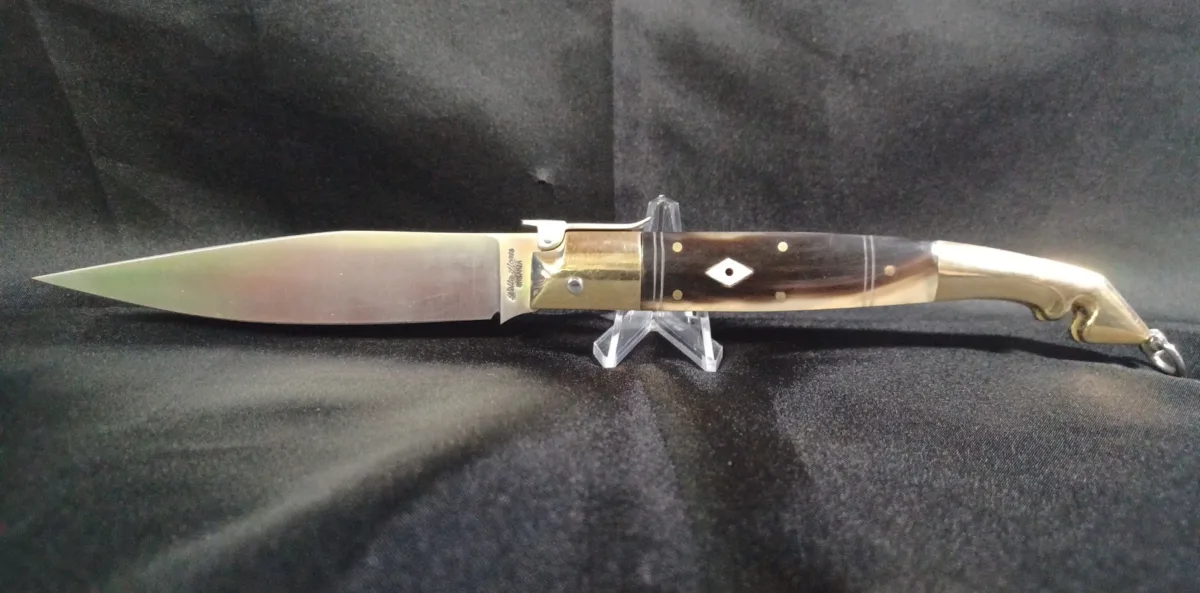
PATTADESA
Not far from the shores of Lake Perno, Pattada is a typical tailor made inland village. It retains a beautiful historic center charecterized by granite houses and buildings in neo classical and Art Nouveau style. Thanks to the skill of its “frailRzos(blacksmiths), for over a century it has been the main production center of the of the knife known as “resolza pattadesa”, born between the 19th and 20th centuries as an evolution of older models of monobloc types. The ancient craft was probably also favored by the presence of a rich deposit of iron ore not far from the town. The Pattadesa is today considered the knife par excellence and a symbol of identity for all of Sardegna and has achieved international fame as 1 of the finest collectors knives!! In fact, there are numerous artisans who create the pattadesa not only in Pattada but throughout the island, respecting the canons of typicality and innovating it with newe productions based on the creativity of the individual cutler and on the variety of precious materials also of exotic origin, or synthetic materials such as resins with an appearance very similar to wood.
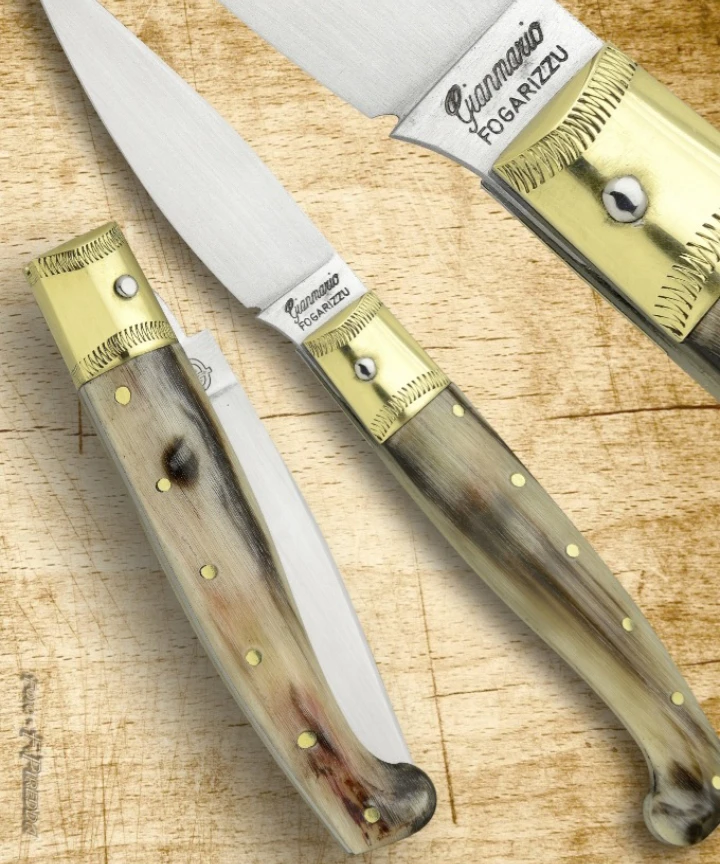
SANFRATELLANO
The city of San Fratello (which owes its name to the 3 Holy brothers, Alfio Filadefio and Cirino), is a small village nestled between the Nebrodi Mountains and the sea, in the northern part of Sicily. It was the seat of the Greek city of Apallonia and it has the particularity that a Gaelic-Italic dialect is the spoken heritage of the Norman domination of the XI century, practically incomprehensible for the rest of the Sicilians. Besides the typical horses of the place, SanFratello is known for its knife. The “sanfratellano” type was the knife owned by the entire population and was used for any kind of use, but mostly, it was the knife used by shepherds, not only of the village itself but of the whole area, who sometimes were willing to travel many miles just to have in their pocket 1 of these famous knives! As in other knives from the same “peasant” style also the “Sanfratellano” type has a blade in the shape of an olive leaf and horn handle, however there are examples with the handle in copper or in some cases aluminum. The metal parts that make up the knife are forged by hand and are steel (blade) and iron (handle).

SARACCA
The Saracca in Ramagna dialect is a classic historic ramagna fighting knife dating back to the mid-1800s ans a distant relative of Roman knives. This Ramagna knife originally from the Ravenna area soon spread its production throughout most of the region. It was born as a dueling weapon in a period where the knife was forbidden, but regularily used in tavern fights and in the illegal activities of the brigands of the time. Also used in the countryside and in everyday use due to its robustness, in fact the Saracca knife has a spring fixed to the handle with 2 screws with a rectangular release.
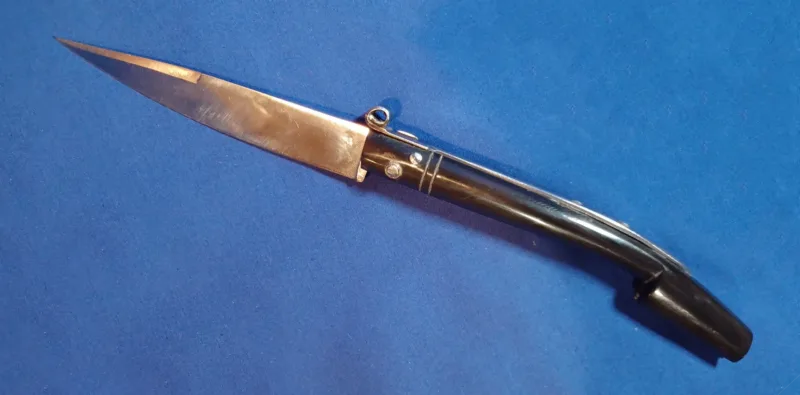
ZUAVA
The knife characteristically has a metal frame covered on the outside with various animal horn or wood. The Zuava has a long history. In fact its name comes from an old Napoleanic military corps, known as The Zouves, who were probably equipped with a blade similar to this knife, which still today is known as a french blade. Its name takes the feminine form since it comes from the expression “alla zuava”. This sturdy easy to handle knife was used for all kinds of purposes, from hunting and skinning animals to working in the fields or at home. It was a treasured possession of anyone who was lucky enough to own 1 and was even used for eating. With this versatile range of uses, it was the most well-known knife made in Scarperia and many people considered it to be the knife of Scarperia.
